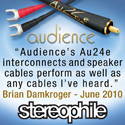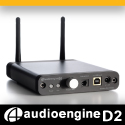|
|
You are reading the older HTML site
Positive Feedback ISSUE 63
accuphase Clean Power Supply PS-520 as reviewed by Marshall Nack
For years Lynn has been urging me to write more concisely. So, I'm going to take her advice—I'm going to begin with the conclusion. The new Clean Power Supply PS-520 does exactly what you expect a first rate active power conditioner from Accuphase to do. Interested readers will find some noteworthy particulars further down. Those who are uninterested in power conditioning might consider stopping here. First let me tell you what it doesn't do. In their pursuit of resolution, many conditioning products inadvertently constrict dynamic flow. They vacuum up what audiophiles describe as air, and they thin body. The PS-520 avoids all of that—au contraire. Accuphase has always done air better than anybody. The same goes for dynamic relationships. It keeps dynamics flowing even as it clarifies them. And it enhances body. The Accuphase Lineage That last sentence—the part about it enhances body—should surprise you, as it did me, because Accuphase has never been associated with beefy bodies. Pure and ultra-refined come to mind instead. My prior acquaintance with the brand dates from about a decade ago, when I owned the PS-500 power conditioner. Yes, it was divinely refined, but to such a degree as to border on effete at times. The PS-500 was superseded by the PS-510 in 2006. In turn, this model was just replaced by the brand-new PS-520. Meanwhile, things have been happening in the Accuphase design shop and the house sound has been evolving. In discussion with the importer, I learned that Accuphase began making changes in the last five or so years, shooting for more weight and punch. I needed no more proof of that assertion than the DP-600 SACD Player I just reviewed (and subsequently purchased for my reference system). Let's start with Johann Sebastian Bach – Cantatas and Concerto (Carus 83.302), with the fabulous Emma Kirkby. This recording dates from 1999 when Emma was in mid-late career. I began with the DP-600 connected to the TARA Labs IDAT active conditioner. There is a touch of strain in her voice, a little bit of hardness whenever she comes to a crescendo. It got me thinking she may be past her prime. But when the same disc is played with the PS-520 in place of the IDAT not a trace of strain remains and the otherworldly purity and sweetness of her soprano is there once again. Both of these conditioners claim to purge noise and distortion in the power line. (All conditioners make that claim.) You can read their white papers online. However, one listen is all it takes to know that, just as with amplifiers or any other component, some work better than others. The PS-520 maintains the excellent frequency integration of the DP-600, but with the reduced distortion and enhanced resolution the timbral envelope becomes crystal clear. Music should be like a finely woven fabric. Acoustic instruments activate layers of harmonics around the principle note—you should never hear the principle note in isolation. The PS-520 clarifies the harmonic structure, exposing all the layers that get excited, and allows you to parse these fine threads. Something similar happens to the soundstage. The PS-520 allows you to disentangle individual players and focus on them or, alternately, it lets you stand back and view the whole—the choice is yours. You can shift attention between a single voice or step back to gather the whole—just like at a real concert! This is true transparency. Through the IDAT you don't have that option—massed instruments tend to form a block that doesn't allow this "see into" access. Technology The technology in the PS-520 is designed to condition the incoming AC in two important ways:
From the website: "The power source waveform containing noise and distortion is compared to a highly accurate and stable reference waveform… Based on this comparison, the PS-520 then adds or subtracts exactly the required amount of correction to create a clean power supply. The required compensation typically is only a fraction of overall power, which allows the PS-520 to operate with high efficiency while producing little heat." Graphically, your AC line tends to look like this:
AC waveform from the wall AC exiting from the PS-520 looks like this:
AC waveform exiting from the PS-520 The Particulars OK, I promised you in the first paragraph I'd go into some interesting particulars. I came across a spectacular reference quality SACD, Gene Bertoncini's solo acoustic guitar outing on Body and Soul (Ambient Records cd-001). FYI, Ambient Records is a boutique record label with an emphasis on state of the art technology. The owner is an audiophile.
In this example, when you power the DP-600 through the PS-520, you'll find frequency extremes have been reined in and the midrange dominant. The result may not be as exciting, however, it is keenly accurate to the instrument! You will clearly discern that the guitar has nylon strings—without the PS-520 they could have been steel. What's happened is the splash around the high frequencies has been removed and the loose, uncontrolled bottom has been tightened up. On the other hand, here's something unique in the realm of conditioners, something I can't recall hearing from any other conditioning product. I think many audiophiles will relate to this example. Sometimes when I power up the system it seems like a grey curtain has descended between the music and me. The presentation simply lacks life and color. The music is Dead On Arrival. I'm going out on thin ice, but I'm going to posit a theory: Can it be that the "grey curtain" descends when high levels of dirt are on the household AC line? Noise and distortion sound grey—that's what you are hearing in place of the signal at these times. Even with gear at the level of the DP-600 this can happen. Well, it never occurred with the PS-520 in line. Which makes me think that what the PS-520 does to repair the AC sine wave restores the signal and brings back treble color. The PS-520 boosts resolution, but I doubt that anyone would find it analytical. Its cluster of effects on balance aligns more to the musical side. It makes things a bit more beautiful. The PS-520 even imparts a warmish, golden-hued tinge to the soundstage. Yes, this is coloration, but what a pleasant one! The PS-520 is especially suitable for audiophiles whose tastes run to unamplified classical and acoustic jazz, who prize subtlety and beauty of a realistic sort. The shoe may not fit fans of other genres or those interested in a strictly neutral presentation, with all the warts on display. Installation / Cosmetics The PS-520 chassis matches the DP-600 SACD Player and continues the classic styling Accuphase is known for. From the brushed gold faceplate to the built-in isolation feet, everything about it is high-class.
I situated it on my TAOC rack, although its faceplate is a mite too tall for a standard shelf. The front footers were half on/half off the isolation platform. The PS-520 accepts a standard IEC for incoming power and has eight AC outlets for your components. I used K-S Elation! power cords exclusively. The Front-Panel Meter The front-panel meter can monitor five functions selectable from pushbuttons on the front panel.
You can choose to view:
Protection Features The PS-520 has sophisticated protection features for handling AC spikes, DC voltage in the output, or internal over-heating. The PS-520 was also superb at noise rejection and minimizing ground hum from analog source. I played around with several configurations of turntable and / or phono stage plugged into the conditioner or power strips. None caused ground hum problems. My assessment of the PS-520 was based on swapping the DP-600 between it and three other power delivery options: the TARA Labs IDAT active power conditioner; the Audience Adept Response; a prototype K-S passive distribution box. Caveat Emptor When I plugged the mbl 6010D line stage into it, the sound began to remind me of the old days with the PS-500 model. It became polite and the overly refined sound was back. You will have to judge whether each of your components likes being plugged into it. Note: I normally prefer the 6010D straight into the wall and don't use a conditioner. Further note: I had the Audioaero La Source SACD Player available and it definitely liked being conditioned by the PS-520. Ditto for the Modwright SONY SCD-XA-5400ES. I had a chance to compare the PS-520 to its predecessor PS-510 (which had the same MSRP, by the way). They were close. Weight, punch and tonal balance were about the same, but the PS-510 fell off in two ways. Its treble is a bit hot and its soundstage is not as transparent. Images seem a bit blocked and don't open up like they do with the PS-520. Here's something you may want to try. If a little less refinement and firmer imager borders along with a boost in dynamics sound attractive, consider a set of TITE-35S component footers, made by TAOC. I like them under the PS-510. (I had already shipped the PS-520 back by the time I thought of trying this.) Doubling up with another set under the DP-600 went a bit too far for my taste. Conclusion When most people think about the Accuphase PS-520 Clean Power Supply the first thing that will come to mind is the expense. There's no escaping that. It does all the things you'd expect a first-class power conditioner to do and, because it's from Accuphase, it reproduces connoisseur-level details like timbral delicacy and the reproduction of air that no other product can match. And, like the companion Accuphase DP-600 SACD Player, the PS-520 also exhibits Accuphase's new voicing: the ultra-refinement the brand is known for is now joined with full body and low-end weight and power. It is a marvelous combination. I tried it with several digital front-ends, all to good effect. However, something special happens when it is paired with the companion Accuphase DP-600 SACD Player: Performance leaps and new vistas open up. This combo is unmatched, especially for unamplified instruments—classical and acoustic jazz enthusiasts take note. Once you hear this combination there is no going back. Despite the expense, the Accuphase PS-520 should be considered an essential accessory to the Accuphase DP-600 SACD Player. Marshall Nack
Clean Power Supply PS-520
Accuphase Laboratory, Inc Importer
Axiss Distribution, Inc.
|











